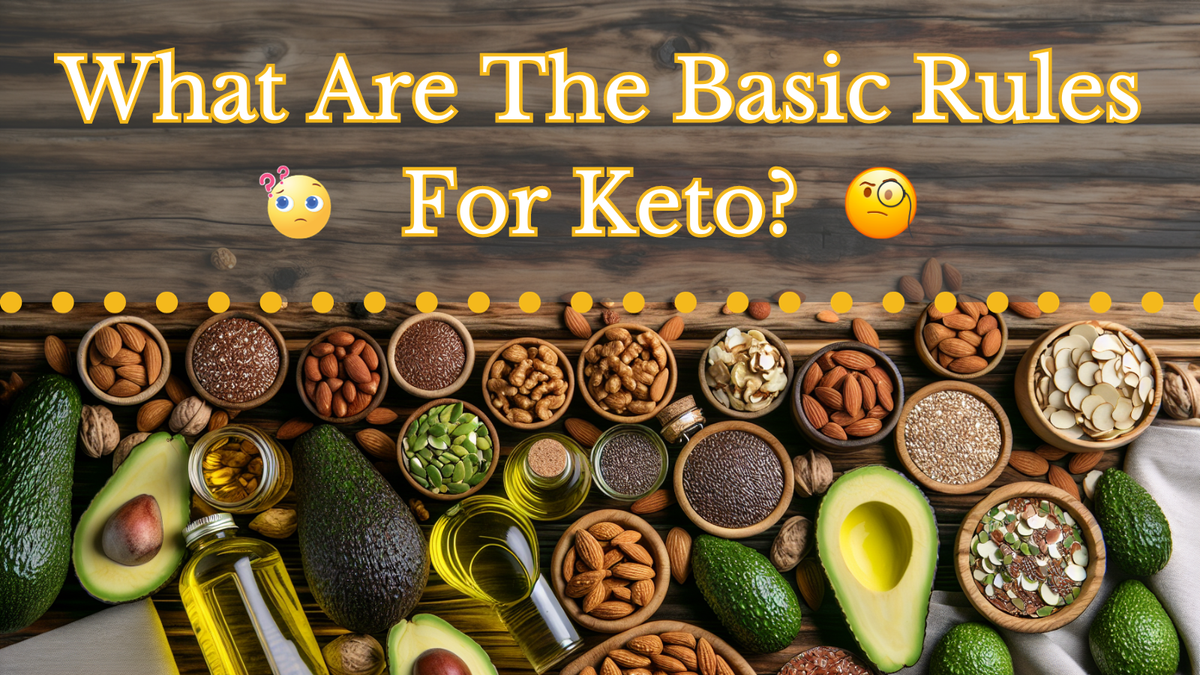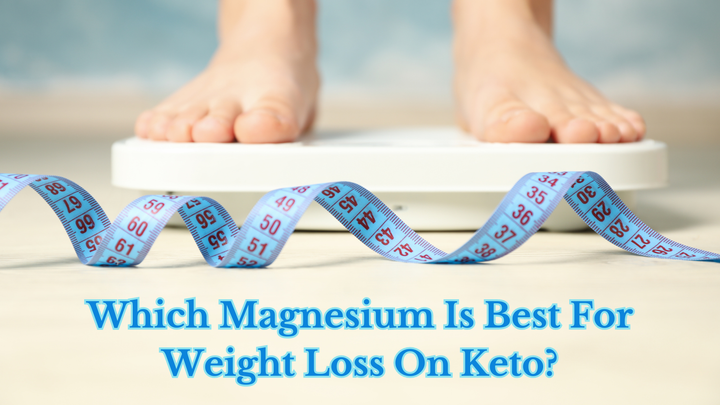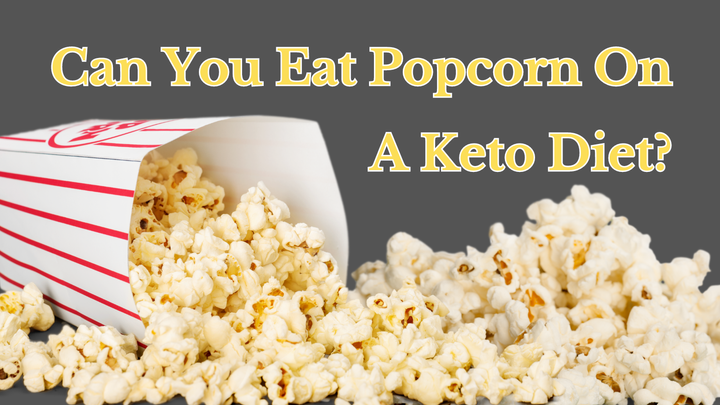Understanding Keto: What Are the Basic Rules for Keto Diet Success?


If you’re seeking a straightforward guide to the ketogenic diet, you’ve come to the right place. ‘What are the basic rules for keto?’ This is the question we hear most from beginners interested in this low-carb, high-fat diet.
The rules are simple: minimize your carb intake, prioritize fat consumption, and maintain moderate protein levels to switch your body into ketosis—a state where fat is burned for fuel instead of carbs.
This introduction is your starting point, laying out the keto framework without overwhelming details, and prepares you for the comprehensive journey through each rule and its application that lies ahead.
Key Takeaways
- The ketogenic diet is based on high fat, moderate protein, and low carbohydrate intake, aiming to induce a metabolic state called ketosis for benefits such as weight loss and improved brain function.
- Foods to embrace on a keto diet include healthy fats like avocados and oils, high-quality proteins like grass-fed meat and low-carb vegetables like leafy greens; whereas grains, starchy vegetables, and high-sugar fruits should be avoided.
- Different types of ketogenic diets cater to various needs, such as the Standard Ketogenic Diet for beginners, and adaptations like Cyclical Ketogenic Diet for athletes. It’s important to be aware of both the health benefits and potential risks of a keto diet.
The Core Principles of Keto
At its core, the low carb high fat ketogenic diet revolves around a simple principle: high fat, low carb, and moderate protein intake.
This unique macronutrient distribution paves the way for the body to enter a metabolic state called ketosis, where it burns fats for energy instead of carbohydrates.
This shift has been linked to a host of benefits, including weight loss, improved brain function, and better control over blood sugar levels. Keto diets, as a popular term for the ketogenic diet, have gained widespread attention for their potential health benefits.
Sounds intriguing? Let’s delve deeper into the three key principles of the keto diet.

Low Carb Intake
The ketogenic diet, a popular low carbohydrate diet, primarily focuses on minimizing your carb intake, which is essential for inducing ketosis.
This metabolic state prompts your body to burn fat as its primary energy source. A daily net carbohydrate intake of around 20-30g is usually recommended on a low carb diet.
But what exactly are net carbs? Simply put, net carbs are the total carbs in a food, minus the fiber content. By focusing on net carbs, the ketogenic diet promotes weight loss and helps maintain stable blood sugar levels.
High Fat Consumption
In the absence of carbs, fats become the primary dietary component. About 75% of your daily calorie intake should derive from fats in a low carb high fat diet, such as the ketogenic diet.
This includes healthy fats from sources such as avocados, nuts, seeds, and oils. Consuming high fat on a keto diet not only fuels your body but also brings about numerous health benefits, including reduced body fat mass, improved blood lipids, lower blood sugar levels, and the ability to enjoy foods high in both saturated and unsaturated fats.
Moderate Protein Intake
Proteins play a vital role in preserving muscle mass, but their intake should be kept moderate on a keto diet as overconsumption can lead to glucose production, potentially disrupting ketosis.
The suggested daily intake of protein on a keto diet is around 25% of your total caloric intake.
This balance ensures that you get enough protein to meet your body’s needs without disrupting the state of ketosis.
Foods to Embrace on a Keto Diet
Having covered the core principles of the ketogenic diet, we can now explore the various foods that you can incorporate into this diet.
Essentially, the keto diet revolves around three main food groups: healthy fats, proteins, and low-carb vegetables. Let’s explore each of these in detail.
Healthy Fats

Healthy fats are the cornerstone of a ketogenic diet. Primary sources include:
- Avocados
- Nuts
- Seeds
- Oils
These sources help meet the high fat intake required by the high fat diet. Among the oils, olive oil, avocado oil, and coconut oil are especially recommended.
As for nuts and seeds, those low in net carbs and high in fats, such as:
- pecans
- macadamia nuts
- flax seeds
- hemp seeds
- shelled pumpkin seeds
Incorporating healthy fats, including a limited amount of saturated fat, into your diet can help you lose weight, improve body composition, increase satiety, and enhance heart health.
Proteins

High-quality proteins are integral to a ketogenic diet. This includes grass-fed meats, eggs, and fish.
Among fish species, Atlantic Mackerel, Farmed Arctic Char, Anchovies, Farmed Salmon, Wild King Salmon, and Sardines are particularly beneficial due to their high omega-3 fatty acid content.
Eggs are another versatile protein source, offering minimal carbs and vital vitamins and minerals.
Proteins play a crucial role in a ketogenic diet by supporting the maintenance and protection of the body’s structures and functions, including muscles, heart, liver, and kidneys.
Low-Carb Vegetables

Vegetables are an essential part of a balanced diet, and the ketogenic diet is no exception.
However, the focus is on low-carb veggies. These include leafy greens, broccoli, and cauliflower. These veggies are not only low in carbs but also packed with vitamins and minerals.
For example, leafy greens like kale and spinach are rich in iron, magnesium, phosphorus, and folic acid.
Broccoli and cauliflower, on the other hand, are excellent sources of vitamin C, vitamin K, and fiber.
Foods to Avoid on a Keto Diet
While there’s a plethora of foods you can enjoy on a ketogenic diet, there are certain foods that you should ideally avoid. These include high-carb foods like grains, starchy vegetables, and sugary fruits.
Let’s take a closer look at each of these food groups and why they should be avoided.
Grains

Grains, such as wheat, rice, and oats, are typically high in carbohydrates and, therefore, not recommended on a keto diet.
This is because their high carbohydrate content can hinder the body from reaching or maintaining ketosis. Moreover, many grains contain gluten, making them unsuitable for individuals following a keto diet.
Starchy Vegetables

Starchy vegetables like corn, potatoes, and peas are also best avoided on a keto diet. These veggies are high in carbs, which can make it more challenging to reach ketosis.
Instead, opt for non starchy vegetables, such as low-carb alternatives like zucchini, bell peppers, and asparagus.
These veggies not only fit into your carb limit but also offer a host of nutritional benefits.
Sugary Fruits

While fruits are generally considered healthy, they can be quite high in sugar. High-sugar fruits like bananas, apples, and grapes should be limited on a keto diet.
The ideal sugar intake on a keto diet is 0 grams per day, but it is crucial to stay under the overall daily carb limit.
Instead, consider incorporating low-sugar fruits like avocados and berries into your diet.
Meal Planning and Preparation

Once acquainted with the foods to include and exclude from a ketogenic diet, the subsequent step involves meal planning and preparation.
This is a fundamental step to ensure consistency and adherence to the diet over an extended period.
We will now examine some strategies that can simplify meal planning and preparation.
Meal Planning Strategies
When it comes to meal planning, a few strategies can make your life easier.
First, develop a meal plan that focuses on high-fat, low-carb foods. Then, consider creating a list of your favorite keto meals and incorporating them into your bi-weekly meal plan. This ensures variety and keeps your meals interesting.
Planning for dining out is also crucial. When dining out, it’s essential to have a well-thought-out plan that is consistent with your keto objectives.
This way, you maintain control over your diet and avoid disrupting ketosis.
Cooking Techniques
Honing your cooking skills is also an integral part of the keto lifestyle. Here are some tips to help you:
- Experiment with keto-friendly recipes
- Try new cooking techniques
- Use keto-friendly cooking oils like sesame oil, avocado oil, coconut oil, extra virgin olive oil, MCT oil, and butter
When preparing meats, opt for grass-fed and organic options. For grilling vegetables, go for low-carb options like:
- zucchini
- bell peppers
- Brussels sprouts
- asparagus
- eggplant
- green beans
- mushrooms
- radishes
- cauliflower
- broccoli
and more.
Overcoming Common Keto Challenges
Starting a keto journey comes with its own set of challenges including managing the keto flu, maintaining electrolyte balance, and dining out. Nonetheless, these difficulties can be effectively tackled with appropriate strategies.
Let’s learn how.
Keto Flu

Keto flu is a common side effect experienced by many people when they first start a ketogenic diet. This is a result of your body transitioning into a state of ketosis.
Symptoms include fatigue, headache, and nausea, and they typically last for a few days to a week or two.
To manage keto flu symptoms, it’s crucial to stay hydrated and make necessary dietary adjustments.
Electrolyte Balance
Maintaining electrolyte balance is another crucial aspect of the keto diet.
As your body enters ketosis, the kidneys excrete higher amounts of water and electrolytes, making it important to maintain adequate levels.
To do this, include keto-friendly dietary sources of electrolytes such as dark chocolate, avocado, low-carb nuts, fish, and leafy greens in your diet.
Dining Out

Dining out can be a challenge when on a ketogenic diet, but it doesn’t have to be. The key is to plan ahead and know your options.
Many restaurants now offer keto-friendly choices, and you can always customize your order to suit your dietary needs.
Don’t be afraid to communicate your dietary needs to the staff and ask for modifications to fit the keto diet.
Different Types of Ketogenic Diets
Although our primary focus has been on the standard ketogenic diet, it’s essential to acknowledge various other versions of the ketogenic diet, each boasting its unique characteristics and benefits. These include:
- The Standard Ketogenic Diet (SKD)
- The Cyclical Ketogenic Diet (CKD)
- The Targeted Ketogenic Diet (TKD)
- The High-Protein Ketogenic Diet (HPKD)
Let’s explore each of these in detail.
Standard Ketogenic Diet
The Standard Ketogenic Diet (SKD) is the most common form of the ketogenic diet. It is characterized by a high fat intake (around 75% of total daily calories), moderate protein consumption, and very low carbohydrate intake.
This version of the ketogenic diet is best for those new to the keto lifestyle and is typically the starting point for beginners.
Cyclical Ketogenic Diet
The Cyclical Ketogenic Diet (CKD) is a specialized version of the ketogenic diet designed for athletes or individuals with very high activity levels.
It involves alternating periods of strict ketogenic dieting with periods of higher-carb intake.
The strategic high-carb refeeds play a crucial role in refilling depleted muscle glycogen, which is essential for athletes during intensive training sessions.
Targeted Ketogenic Diet
The Targeted Ketogenic Diet (TKD) is a variation of the ketogenic diet designed for individuals who engage in high-intensity exercises.
It is based on the standard ketogenic diet, but includes an extra 25-50 grams of net carbs around workout periods.
This provides the necessary energy for the high-intensity workouts, while still maintaining the benefits of a ketogenic diet.
High-Protein Ketogenic Diet
The High-Protein Ketogenic Diet (HPKD) is similar to the standard ketogenic diet, but includes a higher proportion of protein.
This is particularly suitable for individuals such as bodybuilders and those seeking effective weight loss.
While fat still makes up a large portion of the diet, protein intake can be as much as 35% of total daily calories.
Health Benefits and Potential Risks
As with any diet, the ketogenic diet presents both health benefits and potential risks. Despite its significant benefits, awareness of potential risks is imperative to ascertain the suitability of the diet to your personal health needs.
Let’s delve into these aspects.
Health Benefits
The health benefits of a ketogenic diet are numerous. This includes:
- Weight loss
- Reduced inflammation
- Improved heart health
- Increased energy levels
The diet works by transitioning the body’s metabolism from carbohydrates to fats, which frequently leads to substantial weight loss for individuals.
It also has the potential to reduce inflammation in the body, which can be beneficial for individuals with inflammatory conditions.

Additionally, many people report experiencing the following benefits on a ketogenic diet:
- Higher energy levels due to decreased insulin production from lower carb intake
- Metabolic shifts that increase energy production
- More stable and elevated energy levels
Potential Risks
While the ketogenic diet has many health benefits, it is not without potential risks.
The diet is high in fats and low in carbs, which can lead to nutrient deficiencies if not properly balanced. It can also increase the risk of developing kidney stones and osteoporosis.
Additionally, due to the restrictive nature of the diet, it may be difficult to maintain long-term.
Hence, it’s recommended to consult a healthcare provider or a dietitian before starting a ketogenic diet, especially if you have any pre-existing health conditions.
Keto Diet Success Stories and Tips
Firsthand success stories from individuals, including those who have achieved significant weight loss and celebrities who have adopted the keto lifestyle, offer invaluable insights into the effectiveness of the ketogenic diet. These narratives stand as a testament to the diet’s transformative power.
Additionally, we’ll share practical tips from successful keto dieters to help you make the most of your keto journey.
Summary
The ketogenic diet is a unique approach to weight loss and overall health that has transformed countless lives.
By focusing on high fat, low carb, and moderate protein intake, the ketogenic diet helps your body enter a metabolic state called ketosis, where it burns fat for energy instead of carbs. This shift can lead to significant weight loss, reduced inflammation, and increased energy levels, among other benefits.
However, like any diet, the ketogenic diet comes with its own set of potential risks, including nutrient deficiencies and kidney stones. Thus, it’s important to consult a healthcare provider before starting a ketogenic diet, especially if you have pre-existing health conditions.
Frequently Asked Questions
What is the main rule for keto diet?
The main rule for a keto diet is to consume under 25 net carbs per day, which is around 5% of your daily food intake. Focus on high-fat, low-carb foods like eggs, meats, and low-carb vegetables to stay within the recommended macronutrient ratios.
How does the keto diet work for beginners?
The keto diet works for beginners by reducing total carbohydrate intake to less than 50 grams a day, with a focus on high fat intake, moderate protein consumption, and low carb intake. This helps the body enter a state of ketosis, burning fat for fuel.
What foods can you eat on a keto diet?
You can eat fish, seafood, low-carb veggies, cheese, avocados, poultry, eggs, nuts, seeds, healthful oils, plain Greek yogurt, and cottage cheese on a keto diet. Enjoy these options!
What are the potential risks of a ketogenic diet?
The potential risks of a ketogenic diet include nutrient deficiencies, kidney stones, and challenges in maintaining the diet long-term. It's important to consult a healthcare provider before starting the diet, especially if you have pre-existing health conditions.


